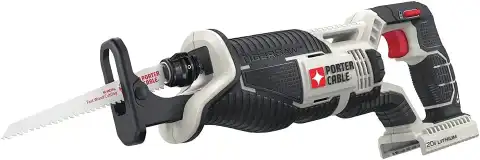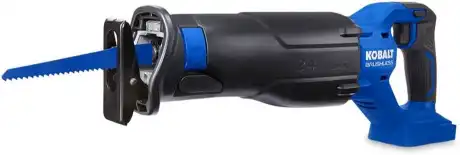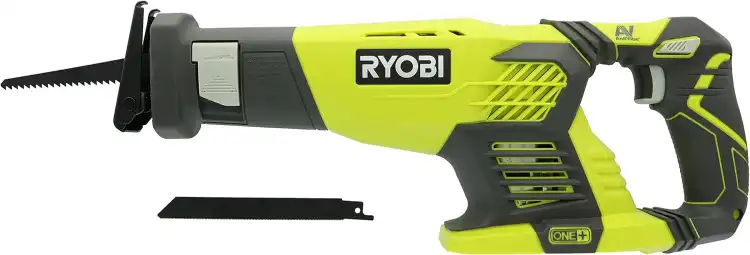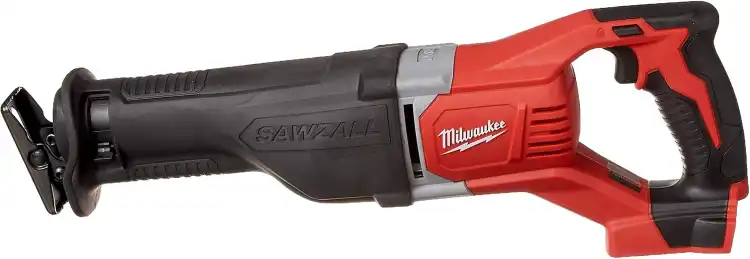A reciprocating saw is your go-to tool for tackling tough cuts with speed and precision. Whether you’re demolishing old structures, trimming pipes, or making quick adjustments, this powerful saw’s versatile design allows it to cut through wood, metal, drywall, and more with ease. Its back-and-forth blade motion makes it ideal for hard-to-reach areas and tight spaces, offering flexibility where other saws fall short.
With the ability to swap out blades for different materials and a variety of features like variable speed control and anti-vibration technology, a reciprocating saw is a must-have for both DIYers and professionals. It’s the perfect tool to handle any heavy-duty project, from home renovations to emergency repairs.
If you’re looking for efficiency and cutting power, investing in a reciprocating saw will transform how you tackle your toughest jobs.
Our Top Reciprocating Saw Picks

BOSCH RS428 14 Amp Reciprocating Saw
Check on AmazonKey Specs
- Power: 14 Amps
- Weight: 8 pounds
- Blade Material: High-Speed Steel
- Surface Recommendation: Wood
- Vibration Control: Anti-vibration handle with counterbalance technology
The BOSCH RS428 14 Amp Reciprocating Saw is a powerhouse tool designed for heavy-duty cutting. It delivers a 14 Amp motor for efficient performance while maintaining a lightweight design at just 8 pounds, providing the best power-to-weight ratio in its class. Equipped with Vibration Control System, this saw utilizes counterbalance technology and an anti-vibration handle to reduce hand fatigue and ensure smoother operation during extended use. Ideal for wood cutting, it outperforms competitors with its impressive power and minimal vibration.

PORTER-CABLE 20V MAX* Reciprocating Saw
Check on AmazonKey Specs:
- Power Source: 20V MAX* Battery
- Stroke Length: 1 inch
- Speed: 3,000 SPM
- Blade Material: High-Speed Steel
- Special Feature: Variable Speeds, Tool-Free Blade Release
The PORTER-CABLE 20V MAX Reciprocating Saw* is a versatile, cordless tool designed for efficient cutting. Powered by the 20V MAX battery system, it features a 3,000 strokes per minute (SPM) drivetrain and a 1-inch stroke length, enabling fast and effective cuts. Its variable speed trigger provides control for various materials, while the pivoting shoe ensures constant contact for smoother cuts. The compact 14-1/2-inch length and over-molded handle offer a comfortable, low-strain grip, making it ideal for extended use and tight spaces.

Kobalt 24-Volt Max-Volt Reciprocating Saw
Check on Amazon
Key Specs:
- Power Source: 24-Volt Battery
- Blade Stroke: 1-1/8 inch
- Speed: 0-3,100 SPM
- Blade Material: High-Speed Steel
- Special Feature: Brushless Motor, LED Work Light, Tool-Free Blade Change
The Kobalt 24-Volt Max Reciprocating Saw offers a powerful and efficient cutting experience with its brushless motor, ensuring longer life, more power, and extended runtime. The variable-speed trigger provides enhanced control and precision, while the lock-off switch adds an extra layer of safety. Featuring a 1-1/8-inch blade stroke and 0-3,100 SPM, it cuts through wood and metal effortlessly. Its tool-free blade change and LED work light for low-light conditions make it a convenient tool for any task.

Ryobi P514 18V Cordless One+ Variable Speed Reciprocating Saw
Check on AmazonKey Specs:
- Material: Copper-infused, sweat-wicking, breathable fabric
- Fit: Adjustable cross-chest strap for both left and right shoulders
- Use: Ideal for rotator cuff injuries, sprains, and bursitis
- Comfort: Can be worn under or over clothing
- Durability: Long-lasting fabric resistant to warping and loss of support
The Ryobi P514 18V Cordless One+ Reciprocating Saw offers exceptional control with its non-slip rubber grip, ensuring comfort even in challenging conditions. The anti-vibration handle reduces motor shock, providing precise cuts with minimal effort. Tool-less blade changing allows for quick and easy blade swaps, and the saw’s speed of 0-3,100 strokes per minute ensures smooth, efficient cutting. It’s also backwards compatible with various Ryobi Lithium-Ion and NiCad batteries, making it a versatile tool for all your cutting needs.

Milwaukee 2621-20 M18 18V
Check on AmazonKey Specs:
- Power Source: 18V Battery
- Blade Material: Metal
- Special Features: Quick Lok Blade Clamp, All-Metal Gearbox, Counterbalance Mechanism
- Battery Compatibility: M18 Lithium-Ion (various models)
- Technology: REDLINK Intelligence
The Milwaukee 2621-20 M18 18V Reciprocating Saw is designed for tough jobs with its QUICK LOK blade clamp, making blade changes effortless. The all-metal gearbox ensures durability, even in harsh conditions, while the counterbalance mechanism reduces vibrations for smoother operation during heavy cutting tasks. Thanks to REDLINK INTELLIGENCE, this saw optimizes power usage to prevent overheating, enhancing efficiency. It is compatible with a range of M18 lithium-ion batteries, making it a versatile and reliable tool for various applications.
Understanding the Versatile Reciprocating Saw
A reciprocating saw, also known as a sawzall, is a versatile power tool that is a must-have for any DIY enthusiast or professional tradesperson. It features a push-and-pull blade motion, making it ideal for cutting through a variety of materials quickly and efficiently. However, understanding how to use a reciprocating saw safely is crucial to prevent accidents and ensure successful projects.
Overview of a Reciprocating Saw
A reciprocating saw is a handheld power tool that uses a push-and-pull motion to move the blade back and forth rapidly. This motion allows the saw to cut through materials such as wood, metal, plastic, and even masonry. The saw’s blade protrudes from the front of the tool, making it easy to maneuver in tight spaces.
Parts of a Reciprocating Saw
– Blade: The cutting component of the saw that can be changed depending on the material being cut.
– Trigger: Controls the on/off function of the saw.
– Shoe: The flat metal piece at the base of the saw that rests against the material being cut for stability.
– Handle: Provides a grip for the user to hold and maneuver the saw comfortably.
Types of Reciprocating Saws
1. Corded Reciprocating Saws: These saws are powered by electricity and are typically more powerful than cordless models.
2. Cordless Reciprocating Saws: These saws run on rechargeable batteries, offering more portability but slightly less power than corded versions.
3. Compact Reciprocating Saws: Smaller and lighter versions of reciprocating saws, ideal for overhead or one-handed use.
Safety Precautions
When using a reciprocating saw, safety should always be a top priority to prevent injuries and accidents. Here are some essential safety precautions to keep in mind:
Importance of Wearing Safety Gear
– Safety Glasses: Protect your eyes from flying debris.
– Ear Protection: Reduce the noise level generated by the saw.
– Gloves: Provide a better grip and protect your hands from cuts.
– Dust Mask: Prevent inhalation of dust and debris.
Tips for Maintaining a Safe Work Environment
– Clear the Workspace: Remove any obstacles that may interfere with your cutting.
– Secure the Material: Ensure the material is firmly held or clamped down to prevent movement.
– Stay Alert: Avoid distractions and focus on the task at hand to prevent accidents.
Common Safety Mistakes to Avoid
1. Not Using Both Hands: Always use two hands to control the saw for better stability.
2. Ignoring Kickback: Be aware of kickback, the sudden backward motion of the saw, and adjust your grip accordingly.
3. Using Dull Blades: Replace dull blades to prevent kickback and ensure clean cuts.
Stay safe and enjoy using your reciprocating saw for various projects!
Choosing the Right Blade
Selecting the appropriate blade for your reciprocating saw is crucial for achieving clean and efficient cuts. Different types of blades are designed for specific materials and cutting tasks, so consider the following factors when choosing a blade:
Different Types of Blades for Various Materials
– Wood Cutting Blades: Feature large, widely spaced teeth for fast cutting through wood.
– Metal Cutting Blades: Have smaller, closely spaced teeth to cut through metal efficiently.
– Demolition Blades: Designed with a rugged tooth pattern for cutting through nails, pipes, and other tough materials.
Factors to Consider When Selecting a Blade
1. Material: Choose a blade that is suitable for the material you are cutting.
2. Tooth Per Inch (TPI): Higher TPI blades provide smoother cuts on thinner materials, while lower TPI blades are better for thicker materials.
3.Blade Length: Select a blade long enough to extend past the material being cut for better control and efficiency.
How to Properly Install and Change Blades
1. Unplug Corded Saws: For corded saws, unplug the tool before changing the blade.
2. Securely Lock the Blade: Ensure the blade is securely locked in place before use.
3. Follow Manufacturer Instructions: Refer to the saw’s manual for specific instructions on blade installation and changing.
Choosing the right blade and maintaining it properly will enhance the performance and longevity of your reciprocating saw.
Basic Operation of a Reciprocating Saw
Mastering the basic operation of a reciprocating saw is essential for achieving precise cuts and completing your projects efficiently. Here are some tips on how to operate a reciprocating saw effectively:
How to Hold and Position the Saw
– Use Both Hands: Grip the saw with one hand on the handle and the other on the front of the saw for better control.
– Position the Shoe: Place the shoe against the material being cut to stabilize the saw.
– Maintain a Firm Grip: Hold the saw firmly but without exerting excessive force to avoid fatigue.
Techniques for Making Straight Cuts
1. Mark the Cut Line: Use a pencil or marker to indicate where you want to make the cut.
2. Start Slowly: Begin cutting at a slow speed to establish a straight line.
3. Maintain Control: Keep a steady hand and guide the saw along the marked line for a clean cut.
Tips for Making Curved Cuts
– Use a Narrow Blade: Opt for a narrow blade for better maneuverability around curves.
– Practice Control: Make small, controlled movements to follow the curve accurately.
– Adjust Speed: Slow down the saw speed when navigating tight curves for precision.
Mastering these basic techniques will help you tackle a variety of cutting tasks with ease using your reciprocating saw.
Advanced Techniques
Beyond basic cutting operations, a reciprocating saw can be used for a range of advanced techniques to enhance its versatility. Here are some advanced techniques you can explore with your reciprocating saw:
Cutting Through Different Materials
– Wood: Use a fine-toothed blade for clean cuts in wood.
– Metal: Select a metal-cutting blade for efficient cutting through metal pipes or rods.
– Plastic: Choose a blade with fewer teeth to prevent melting when cutting plastic.
Making Plunge Cuts
– Mark the Entry Point: Indicate where you want to start the plunge cut on the material.
– Angle the Saw: Tilt the saw slightly to initiate the plunge cut smoothly.
– Control Depth: Gradually increase the depth of the cut while maintaining control.
Using a Reciprocating Saw for Demolition Work
– Remove Nails and Screws: Cut through nails or screws embedded in materials during demolition.
– Break Down Structures: Use the saw to dismantle walls, cabinets, or other structures quickly.
– Precision Demolition: Make controlled cuts to avoid damaging surrounding areas during demolition.
Exploring these advanced techniques will unlock the full potential of your reciprocating saw for various projects and applications.
Maintenance and Care
Proper maintenance and care of your reciprocating saw are essential to ensure its longevity and optimal performance. Follow these tips to keep your saw in top condition:
Cleaning the Saw After Use
– Remove Debris: Wipe off any dust or debris from the saw’s body and blade.
– Check for Damage: Inspect the blade and moving parts for any signs of wear or damage.
– Store Clean: Keep the saw clean and free of debris to prevent malfunctions.
Lubricating Moving Parts
– Apply Lubricant: Use a suitable lubricant to grease the moving parts of the saw.
– Regular Maintenance: Lubricate the saw periodically to prevent friction and wear.
– Follow Manufacturer Guidelines: Refer to the saw’s manual for specific lubrication instructions.
Storing the Saw Properly
– Dry Storage: Store the saw in a dry and clean environment to prevent rust or corrosion.
– Secure Position: Keep the saw in a secure position to prevent accidental falls or damage.
– Protect the Blade: Use blade guards or covers to protect the blade when not in use.
By following these maintenance practices, you can prolong the life of your reciprocating saw and ensure it remains in optimal working condition for future projects.
Common Problems and Solutions
While reciprocating saws are reliable tools, they may encounter occasional issues that can affect their performance. Here are some common problems you may encounter with your reciprocating saw and how to address them:
Blade Getting Stuck
– Cause: Dull or damaged blade, incorrect blade installation, or binding in the material being cut.
– Solution: Replace the blade with a sharp one, ensure proper installation, and adjust cutting speed and pressure.
Saw Not Cutting Straight
– Cause: Improper blade alignment, incorrect cutting technique, or worn-out blade.
– Solution: Check blade alignment, practice proper cutting technique, and replace the blade if necessary.
Motor Overheating
– Cause: Continuous heavy use, lack of cooling, or dirty air vents.
– Solution: Allow the motor to cool down, clean air vents, and avoid prolonged heavy use to prevent overheating.
By addressing these common problems promptly, you can maintain the performance and efficiency of your reciprocating saw for long-term use.
Comparing Reciprocating Saws to Other Power Saws
Reciprocating saws offer unique advantages and versatility compared to other power saws on the market. Understanding the differences can help you choose the right tool for your specific cutting needs:
Advantages and Disadvantages of Reciprocating Saws
– Advantages: Versatile cutting capabilities, ability to reach tight spaces, suitable for demolition work.
– Disadvantages: Less precision compared to other saws, can be noisy and produce vibrations during operation.
When to Choose a Reciprocating Saw Over Other Saws
– Demolition Work: Reciprocating saws excel at demolition tasks due to their cutting power and versatility.
– Cutting in Tight Spaces: The compact size and maneuverability of reciprocating saws make them ideal for cutting in confined areas.
– Versatile Cutting: If you need a saw that can cut through a variety of materials quickly, a reciprocating saw is a great choice.
How a Reciprocating Saw Differs from a Jigsaw or Circular Saw
– Reciprocating Saw vs. Jigsaw: Reciprocating saws are more suitable for rough cuts and demolition work, while jigsaws offer more precision for intricate cuts.
– Reciprocating Saw vs. Circular Saw: Reciprocating saws are more versatile for cutting different materials and can reach tight spaces, whereas circular saws are better for straight cuts in wood.
Understanding the unique features and capabilities of reciprocating saws will help you make an informed decision when selecting the right saw for your projects.
DIY Projects Using a Reciprocating Saw
Whether you are a seasoned DIY enthusiast or a beginner looking to tackle new projects, a reciprocating saw can be a valuable tool for various home improvement tasks. Here are some DIY projects you can accomplish using a reciprocating saw:
Building a Backyard Deck
– Cutting Deck Boards: Use a reciprocating saw to trim deck boards to the desired length quickly.
– Demolishing Old Structures: Remove old deck structures or railings efficiently with a reciprocating saw.
– Cutting Notches: Create precise notches in deck posts or beams for a custom fit using a reciprocating saw.
Renovating a Kitchen
– Removing Cabinets: Cut through cabinet screws or nails to dismantle old kitchen cabinets.
– Cutting Countertops: Trim countertops or backsplashes to fit new fixtures or appliances.
– Demolishing Walls: Take down non-load-bearing walls or partitions with ease using a reciprocating saw.
Creating Custom Furniture Pieces
– Cutting Wood Panels: Use a reciprocating saw to cut wood panels for custom furniture projects.
– Assembling Frames: Cut and assemble frames for tables, shelves, or other furniture pieces.
– Adding Details:Create intricate designs or patterns on furniture pieces with the precision of a reciprocating saw.
By incorporating a reciprocating saw into your DIY projects, you can achieve professional results and unleash your creativity in woodworking and home improvement tasks.
Safety Tips for Specific Projects
While using a reciprocating saw for various projects, it’s essential to follow specific safety guidelines to prevent accidents and ensure a successful outcome. Here are some safety tips for specific projects commonly performed with a reciprocating saw:
Cutting Tree Branches
– Wear Protective Gear: Use safety glasses, gloves, and ear protection when cutting tree branches.
– Secure Branches: Ensure branches are stable and supported before cutting to prevent unexpected movement.
– Mind Surroundings: Be aware of your surroundings and avoid cutting near power lines or structures.
Removing Tile
– Protective Equipment: Wear a dust mask and safety glasses to shield yourself from tile debris.
– Start Slowly: Begin cutting tiles at a slow speed to prevent chipping or cracking.
– Use Proper Blade: Select a blade designed for cutting through tile to achieve clean cuts.
Demolishing Walls
– Check for Hazards: Identify and shut off electrical or plumbing lines before demolishing walls.
– Support Structures: Ensure load-bearing walls are properly supported to prevent collapses.
– Work Methodically: Start from the top and work your way down when demolishing walls for safety and efficiency.
By following these safety tips tailored to specific projects, you can complete your tasks with confidence and minimize the risk of accidents when using a reciprocating saw.
Reciprocating Saw Accessories
Enhance the functionality and convenience of your reciprocating saw with the right accessories designed to optimize your cutting experience. Here are some essential accessories for reciprocating saws:
Blade Guards
– Protective Cover: Shield the blade when not in use to prevent accidental cuts or damage.
– Safety Feature: Blade guards add an extra layer of safety when storing or transporting the saw.
– Compatibility: Ensure the blade guard is compatible with your reciprocating saw model for a secure fit.
Carrying Cases
– Portability: Transport your reciprocating saw safely and conveniently with a dedicated carrying case.
– Organization: Keep blades, accessories, and the saw itself organized in a custom-fit case.
– Protection: Protect your saw from dust, moisture, and impacts during storage or transportation.
Blade Storage Solutions
– Organized Storage: Keep your blades neatly organized and easily accessible with a blade storage solution.
– Blade Variety: Store different types of blades for various cutting tasks in a single storage unit.
– Quick Access: Retrieve the right blade quickly when switching between materials or projects.
Investing in quality accessories for your reciprocating saw will not only prolong the life of your tool but also enhance your cutting efficiency and overall user experience.
Reviews of Popular Reciprocating Saws
When choosing a reciprocating saw, it’s essential to consider the features, performance, and user feedback to make an informed decision. Here are reviews of some popular reciprocating saw brands to help you find the right tool for your needs:
Comparison of Top Brands
| Brand | Corded/Cordless | Power Source | Blade Change System | Customer Rating |
|—————-|—————–|————–|———————-|—————–|
| DeWalt | Corded | Electric | Tool-Free | 4.8/5 |
| Milwaukee | Cordless | Battery | Quick-Change | 4.7/5 |
| Bosch | Corded/Cordless | Electric | Keyless | 4.6/5 |
Customer Feedback and Ratings
– DeWalt: Users praise the power and durability of DeWalt reciprocating saws, making them a top choice for heavy-duty cutting tasks.
– Milwaukee: Customers appreciate the portability and battery life of Milwaukee cordless reciprocating saws for on-the-go projects.
– Bosch: Users value the versatility and precision of Bosch reciprocating saws, ideal for both DIY enthusiasts and professionals.
Recommendations for Different User Needs
– Professional Tradespeople: DeWalt corded reciprocating saws are recommended for professionals requiring high power and reliability.
– DIY Enthusiasts: Milwaukee cordless reciprocating saws are ideal for DIY enthusiasts seeking portability and convenience.
– Versatile Users: Bosch corded/cordless reciprocating saws offer a balance of power, precision, and versatility for various cutting tasks.
Consider user reviews and ratings when selecting a reciprocating saw to ensure it meets your cutting requirements and performance expectations.
Conclusion
In conclusion, understanding how to use a reciprocating saw safely and effectively is essential for successful cutting tasks and project completion. By following safety precautions, choosing the right blade, mastering basic and advanced techniques, and maintaining your saw properly, you can maximize the potential of this versatile power tool. Remember to explore DIY projects, follow safety tips for specific tasks, and consider accessories and reviews to enhance your reciprocating saw experience. Stay safe, have fun cutting, and unleash your creativity with the power of a reciprocating saw!
Additional Resources
For more information on power tools, safety gear, and accessories, check out the following resources:
– [Instructional Videos](/tools/): Watch tutorials and guides on using reciprocating saws and other power tools.
– [Recommended Books on Power Tool Safety](/plumbing-tools-list/): Explore literature on power tool safety practices and maintenance tips.
– [Websites for Purchasing Reciprocating Saws and Accessories](/woodworking-tool-list/): Find a wide selection of reciprocating saws, blades, and accessories for your cutting needs.
—
FAQ
How do I choose the right blade for my reciprocating saw?
When selecting a blade for your reciprocating saw, consider the material you will be cutting, the tooth per inch (TPI) of the blade, and the blade length. Choose a blade designed for the specific material, opt for higher TPI for smoother cuts on thinner materials, and ensure the blade length extends past the material for better control.
Can I use a reciprocating saw for cutting metal?
Yes, reciprocating saws are suitable for cutting metal with the right blade. Choose a metal-cutting blade with small, closely spaced teeth for efficient cutting through metal pipes, rods, or sheets. Ensure the blade is securely installed and adjust the cutting speed and pressure for optimal results.
How should I store my reciprocating saw when not in use?
To store your reciprocating saw properly, ensure it is kept in a dry and clean environment to prevent rust or corrosion. Use a dedicated carrying case to transport the saw safely and protect it from dust, moisture, and impacts. Secure the saw in a stable position to prevent accidental falls or damage.
